Abstract
The present paper is aimed at studying the effects of viscosity on thermoelastic interactions in a three-dimensional homogeneous isotropic half-space solid medium whose surface is subjected to a thermal shock and is assumed to be stress free. The formulation is applied to the generalized thermoelasticity based on the GN model without energy dissipation (GN II model). The normal mode analysis together with state-space approach is used to obtain the exact analytical expressions for the field variables considered. Numerical computations are performed for a specific material and the results obtained are represented graphically. Comparisons are made within the theory in the presence and absence of viscosity effects.
1. Introduction
In 1967, Lord and Shulman [1] established a mathematical model of generalized thermoelasticity which referred as ‘LS model’ in order to eliminate the paradox of infinite speed of propagation of thermal disturbances [2]. In LS theory the classical Fourier’s heat conduction equation has been modified by introducing a parameter called relaxation time and the heat conduction equation becomes hyperbolic in nature and thus finite speed of propagation of heat pulses is predicted. After five years of LS theory, Green and Lindsay [3] formulated another model (referred as ‘GL model’). In this model, the Fourier’s law of heat conduction remains unchanged whereas the classical energy equation and the constitutive equation were modified by introducing temperature-rate-dependent terms. In GL model, two relaxation time parameters have been introduced. This model is often called as temperature-rate-dependent thermoelasticity (TRDTE).
Green and Nagdhi [4-6] proposed three theories of generalized thermoelasticity. The first model (GN I) is exactly the same as Biot’s theory [2]. The second and third model is labeled as GN II and GN III model. In GN II and GN III models, the thermal wave propagates at finite speed. An important feature of GN II model is that this model does not accommodates dissipation of thermal energy whereas GN III model accommodates dissipation of energy. One can see the publications [7-15] for many investigations using GN II model. The theoretical investigation and application in thermoviscoelastic materials have become a significant task for solid mechanics due to the rapid development of polymer science and plastic industry as well as the wide use of materials under high temperature in modern technology. Keeping this fact in mind, many researchers [16-25] studied several problems on wave propagation in linear thermoviscoelastic and electro-magneto-thermoviscoelastic solid.
In the present paper, our main goal is to apply the state-space approach to study the effects of viscosity on a three-dimensional thermoelastic homogeneous isotropic half-space solid body whose surface is subjected to a thermal shock and is assumed to be stress free. The formulation is applied to the generalized thermoelasticity based on the GN model without energy dissipation. The normal mode analysis [9, 26] together with state-space approach [27-30] is used to obtain the exact analytical expressions for the variables considered. Numerical computations are performed for a specific material and the results obtained are represented graphically. Comparisons are made within the theory in the presence and absence of viscosity effects.
2. Governing equations
Following [5], the strain-displacement relations, the stress-strain-temperature relations, the equations of motion in absence of body forces and the heat conduction equation in absence of heat source for a homogeneous isotropic thermally conducting viscoelastic solid may be written as:
where:
γe=(3λe+2μe)αT,γ0=(3λ0λe+2μ0μe)αTγe,i,j,k=x,y,z,
where eij are the components of strain tensor, σij are the components of the stress tensor, λ, μ are Lame’s constants, γ=(3λ+2μ)αT is a material constant characteristic of the theory, αT is the coefficient of linear thermal expansion, ρ is the density, δij is Kronecker delta, uiare the components of the displacement vector, k*(>0) is a material constant characteristic of the theory, CE is the specific heat at constant strain, T is the temperature change, T0 is the reference temperature of the medium assumed to be such that |T/T0|≪1, e=ekk is the cubical dilatation, λ0, μ0, γ0 are viscoelastic constants and ∇2≡∂2/∂x2+∂2/∂y2+∂2/∂z2.
3. Formulation of the problem
We shall consider a homogenous isotropic thermoviscoelastic solid medium in three-dimensional space which fills the region:
and is subjected to a time dependent heat source on the bounding plane to the surface x=0. Moreover, the body is initially at rest and the surface x=0 is assumed to be stress free. The initial conditions on all the physical variables are taken to be homogeneous. We shall use the cartesian coordinates (x,y,z). The displacement components thus have the form ui=(u,v,w). Hence the governing equations take the following form:
+[(λe+μe)+(λ0λe+μ0μe)∂∂t](v,xy+w,xz)-γe(1+γ0∂∂t)T,x,
+[(λe+μe)+(λ0λe+μ0μe)∂∂t](w,yz+u,yx)-γe(1+γ0∂∂t)T,y,
+[(λe+μe)+(λ0λe+μ0μe)∂∂t](u,zx+v,zy)-γe(1+γ0∂∂t)T,z,
where:
and a subscript comma denotes spatial derivatives and a superimposed dot represents differentiation with respect to time.
In order to non-dimensionalize the above equations, we define the following non-dimensional parameters:
θ=TT0,σ'ij=σijγeT0,(λ0',μ0',γ0')=c1l(λ0,μ0,γ0),
where l is some standard length.
Introducing the above non-dimensional parameters in Eqs. (5)-(14) and using the relation Eq. (15), we obtain the following set of governing equations (suppressing the primes for convenience):
where ε=γ2eT0/[ρCE(λe+2μe)] is the dimensionless thermoelastic coupling parameter, CT=c3/c1 is the non-dimensional finite thermal wave speed of GN theory, c1=√(λe+2μe)/ρ is the longitudinal waves speed, c3=√k*/ρCE is the finite thermal waves speed of G-N theory and β=μe/(λe+2μe).
Taking differentiation of Eqs. (16), (17), (18) with respect to x, y, z respectively and then adding we get:
We shall consider the invariant stress σ to be the mean value of the principal stresses σij as follows [9]:
Adding the Eqs. (20)-(22) and using Eqs. (15) and (27) we get:
4. Normal mode analysis
The solution of the physical variables can be decomposed in terms of normal modes [9, 26] in the following form:
where u*(x) etc. are the amplitude of the function u(x,y,z,t) etc., i is the imaginary unit, ω (complex) is the time constant and a, b are the wave number in the y and z direction respectively.
Using (29) in the Eqs. (19), (26), (28) and then eliminating e*(x) from the resulting equations we obtain:
where:
Choosing θ* and σ* as state variables in the x-direction, Eqs. (30) and (31) can be written in a vector-matrix differential equation as follows:
where:
The initial conditions of the problem are assumed to be homogeneous and for the stress-free surface x= 0, we assume the boundary conditions in non-dimensional form as follows:
(i) The thermal boundary condition is:
where qn denotes the normal component of the heat flux vector, ν is Biot’s number and r(0,y,z,t) represents the intensity of the applied heat sources on x=0.
All the physical quantities are assumed to be bounded as x→+∞. In order to use the above thermal boundary condition, we use the generalized Fourier’s law of heat conduction in the non-dimensional form, namely:
From Eqs. (33), (34) and (29) we obtain:
where D=d/dx.
(ii) Mechanical boundary condition that the bounding plane to the surface x=0 has no traction anywhere so we have:
which gives on using the normal modes Eq. (29):
5. State space approach
The formal solution of the vector-matrix differential Eq. (32) can be written as (see [27-30] for details):
where:
and we have used the boundary conditions Eq. (36) and the constant θ*0 is to be determined from the boundary conditions Eq. (35).
In the solution Eq. (37) we have omitted the positive exponential part to obtain a bounded solution for large x. Now, we shall first find the form of the matrix exp[-√A(ω)x].
The characteristic equation of the matrix A(ω) can be obtained as:
Let λ1 and λ2 be the roots (distinct) of the Eq. (39), where:
The spectral decomposition of the matrix A(ω) from [31] can be written as:
where E and F are called the projectors of A(ω) satisfying the following conditions (see [31] for details):
Now √A(ω) has the same projectors as of A(ω) (see [31]) and if p1, p2 are the eigenvalues of √A(ω) then p1=√λ1, p2=√λ2. Hence the spectral decomposition of the matrix √A(ω) can be written as:
where:
and E, F satisfy Eq. (41).
Thus, we find:
The Taylor series expansion of the matrix exponential in Eq. (37) has the form:
Using the Cayley-Hamilton theorem we can express A*2(ω) and higher orders of the matrix A*(ω) in terms of I and A*(ω), where I is the second order unit matrix. Thus, the Taylor series in Eq. (45) can be reduced to:
where a0(x) and a1(x) are coefficients depending on x only.
By Cayley-Hamilton theorem, the characteristic roots p1 and p2 of the matrix A*(ω) must satisfy Eq. (46) and thus we get:
The solution of the above system of Eqs. (47) and (48) is given by:
From Eqs. (46) and (49), we obtain:
where:
Finally, the solution of the vector-matrix differential Eq. (32) can be written in the form:
Hence using Eqs. (38), (51) and (52) in (53) the field variables and can be obtained as:
where ,
The boundary condition Eq. (35) gives the value of the constant as:
By using Eqs. (29), (54) and (55) with Eq. (28) we get the cubical dilatational as:
where:
To get the displacement component we will use Eq. (16). By using Eqs. (29), (54) and (56) in the Eq. (16) we can write:
where:
The general solution of the ordinary differential Eq. (57) can be written as:
where and is a constant to be determined from the boundary conditions Eq. (36).
Using Eqs. (29), (54), (56) and (58) in the Eq. (20) we obtain the stress components as:
where:
With the help of the boundary condition Eq. (36) and the Eq. (59) we obtain the constant as:
6. Numerical example and discussions
Since we have where is the imaginary unit, and for small values of time, we can take (real). For the discussions of the nature of dependence of all the physical variables on viscosity, we shall compute them numerically for a particular model. For this purpose, we choose the following numerical values of the relevant parameters for copper like material: (7.76×1010 N/m2, 3.86×1010 N/m2, 0.06 s, 0.09 s, 1.78×10-5 K-1, 383.1 m2/K, 8954 kg/m3, 293 K, 0.0168, 0.25, 3, 1.2, 1.3, 50, 100, 2).
Using the above numerical values, the variations of the temperature distribution , the mean stress , the displacement component and the stress component along axis at two different plane and for a particular time instant have been shown for (i) generalized thermoviscoelastic solid (GTVE) by solid line at 0.0, 0.25, (ii) generalized thermoviscoelastic solid (GTVE) by solid-dot line at 0.4, 0.25, (iii) generalized thermoelastic solid (GTE) by solid-dot (bold) line at 0.0, 0.25 and (iv) generalized thermoelastic solid (GTE) by dashed line at 0.4, 0.25. These variations are shown in Figs. 1-4.
Fig. 1Temperature distribution θ vs. x at t= 0.25
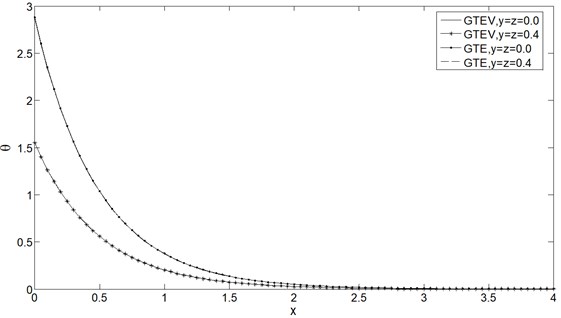
Fig. 2Mean stress distribution σ vs. x at t= 0.25
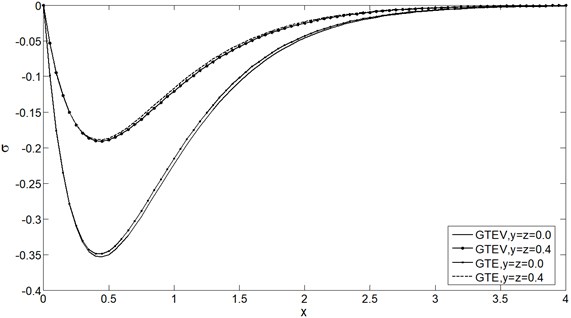
Fig. 3Displacement distribution u vs. x at t= 0.25

From Figs. 1-4 it is clear that and have decreasing effect on , , and for both GTVE and GTE model for fixed . Also it is depicted that the numerical values of , and are greater in GTVE model than GTE model for fixed , , and but Fig. 1 shows that the viscosity has no significant effect on . The maximum value of all the physical quantities attain in the case of GTVE at the plane 0.0.
Fig. 4Stress distribution σxx vs. x at t= 0.25
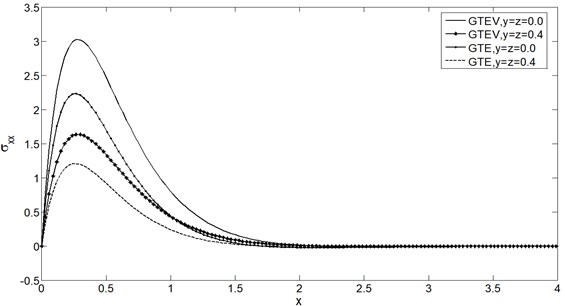
Figs. 5-8 show the distributions of , , and for the GTVE model at 0.0 and 0.4 for two different time instants 0.2 and 0.3. It is clear from all these figures that has increasing effects on all the physical quantities.
Fig. 5Temperature distribution θ vs. x for two time instants
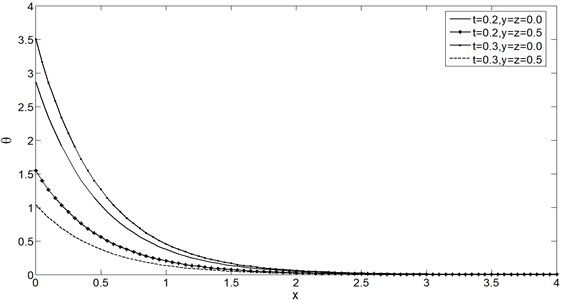
Fig. 6Mean stress distribution σ vs. x for two time instants
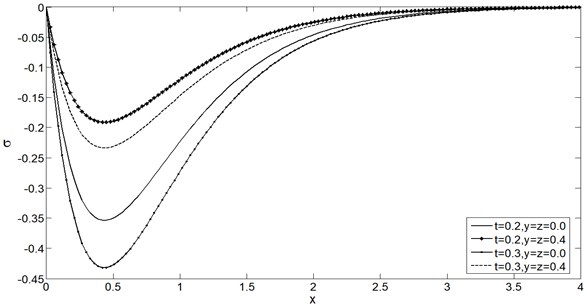
Fig. 7Displacement distribution u vs. x for two time instants
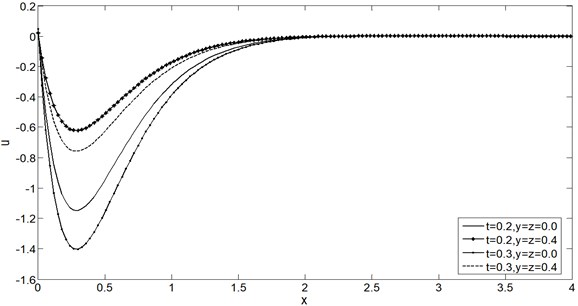
Fig. 8Stress distribution σxx vs. x for two time instants
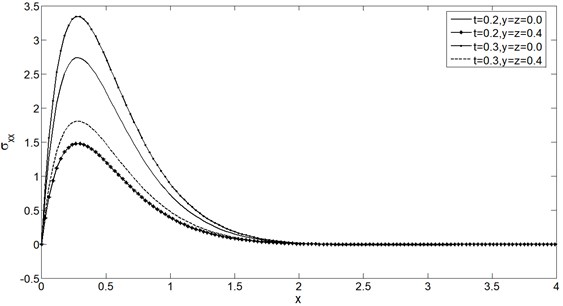
Figs. 9-12 display the temperature , the mean stress , the displacement and the stress distributions at 0.4 with wide range of and . From these figures it can be noted that the speed of the wave propagation of all the physical quantities are finite and coincide with the physical behaviour of elastic materials. Also we can see from all the figures that the boundary conditions Eqs. (35) and (36) are satisfied.
Fig. 9Temperature distribution θ vs. x and t at y=z= 0.4
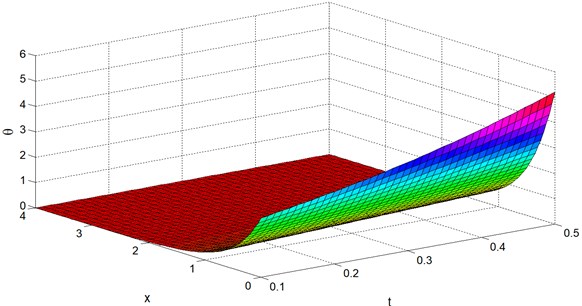
It is clear from Figs. 1-12 that all the distributions considered have a non-zero value only in a bounded region of the space. Outside of this region all the values vanish identically and this means that the region has not felt thermal disturbance yet. Behaviour of all the physical variables at 0.0 and 0.4 are likely to be similar but only differences are lie in the magnitudes.
Fig. 10Mean stress distribution σ vs. x and t at y=z= 0.4
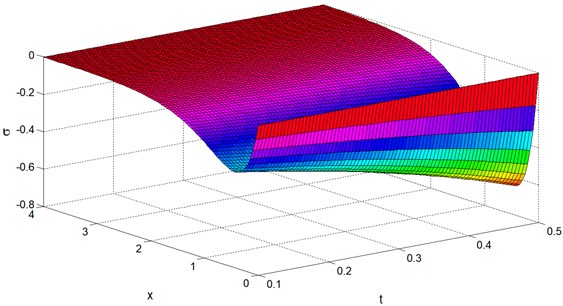
Fig. 11Displacement distribution u vs. x and t at y=z= 0.4
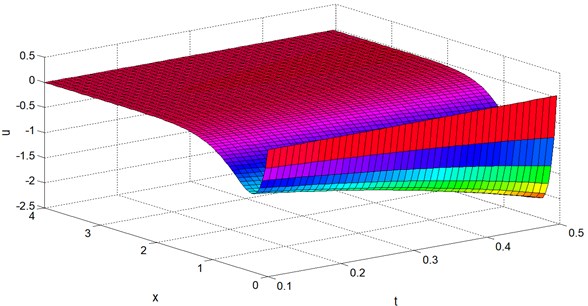
Fig. 12Stress distribution σxx vs. x and t at y=z= 0.4
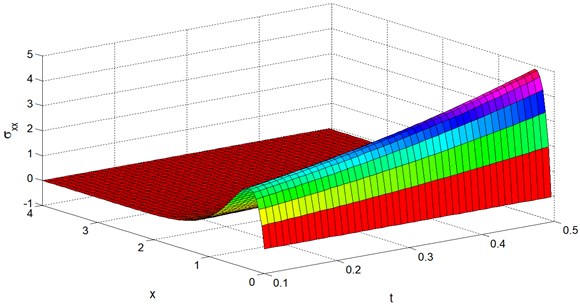
7. Conclusion
Many researchers in the field of generalized thermoelasticity have applied state-space approach only for one-dimensional thermoelastic problem and very few of them can successfully applied for two-dimensional case. In the present paper, we apply state-space approach for solving a three-dimensional generalized thermoelastic problem for the first time. We tried to implement such a very useful technique which may be applied to solve a three-dimensional generalized thermoviscoelastic problem.
References
-
Lord H. W., Shulman Y. A. Generalized dynamical theory of thermoelasticity. Journal of Mechanics and Physics of Solids, Vol. 15, 1967, p. 299-309.
-
Biot M. Thermoelasticity and irreversible thermodynamics. Journal of Applied Physics, Vol. 27, 1956, p. 240-253.
-
Green A. E., Lindsay K. A. Thermoelasticity. Journal of Elasticity, Vol. 2, 1972, p. 1-7.
-
Green A. E., Naghdi P. M. A re-examination of the basic postulate of thermo-mechanics. Proceedings of Royal Society of London, Vol. 432, 1991, p. 171-194.
-
Green A. E., Naghdi P. M. Thermoelasticity without energy dissipation. Journal of Elasticity, Vol. 31, 1993, p. 189-208.
-
Green A. E.,Naghdi P. M. An unbounded heat wave in an elastic solid. Journal of Thermal Stresses, Vol. 15, 1992, p. 253-264.
-
Othman M. I. A., Zidan M. E. M., Hilal M. I. M. The influence of gravitational field and Rotation on thermoelastic solid with voids under Green-Naghdi theory. Journal of Physics, Vol. 2, 2013, p. 22-34.
-
Othman M. I. A., Zidan M. E. M., Hilal M. I. M. Effect of rotation on thermoelastic material with voids and temperature dependent properties of type III. Journal of Thermoelasticity, Vol. 1, 2013, p. 1-11.
-
Sarkar N., Lahiri A. A three-dimensional thermoelastic problem for a half-space without energy dissipation. International Journal of Engineering Science, Vol. 51, 2012, p. 310-325.
-
Gupta R. R. Propagation of waves in the transversely isotropic thermoelastic Green-Naghdi type II and type III medium. Journal of Applied Mechanics and Technical Physics, Vol. 52, 2011, p. 825-833.
-
Lazzari B., Nibbi R. On the exponential decay in thermoelasticity without energy dissipation an of type III in presence of an absorbing boundary. Journal of Mathematical Analysis and Applications, Vol. 338, 2008, p. 317-329.
-
Roychoudhuri S. K., Bandyopadhyay N. Interactions due to body forces in generalized thermos-elasticity III. Computers and Mathematics with Applications, Vol. 54, 2007, p. 1341-1352.
-
Verma K. L. Generalized thermoelastic vibrations in heat conducting plates without energy dissipation. Tamkung Journal of Science and Engineering, Vol. 10, 2007, p. 1-9.
-
Leseduarte M. C., Quintanilla R. Thermal stresses in type III thermoelastic plates. Journal of Thermal Stresses, Vol. 29, 2006, p. 485-503.
-
Taheria H., Fariborza S. J., Eslamia M. R. Thermoelastic analysis of an annulus using the Green-Naghdi model. Journal of Thermal Stresses, Vol. 28, 2005, p. 911-927.
-
Ilioushin A. A., Pobedria B. E. Fundamentals of the Mathematical Theory of Thermal Viscoelasticity. Nauka, Moscow, 1970.
-
Tanner R. I. Engineering Rheology. Oxford University Press, Oxford, 1988.
-
Huilgol R., Phan-Thien N. Fluid Mechanics of Viscoelasticity. Elsevier, Amsterdam, 1997.
-
Ezzat M. A., Othman M. I. A., El-Karamany A. S. State-space approach to two-dimensional generalized thermoviscoelasticity with two relaxation times. International Journal of Engineering Science, Vol. 40, 2002, p. 1251-1274.
-
Ezzat M. A., El-Karamany A. S. The uniqueness and reciprocity theorems for generalizedthermo-viscoelasticity with two relaxation times. International Journal of Engineering Science, Vol. 40, 2002, p. 1275-1284.
-
Abd-Alla A. N., Yahia A. A., Abo-Dahab S. M. On the reflection of the generalized magneto-thermoviscoelastic plane waves. Chaos Solitons Fractals, Vol. 16, 2003, p. 211-231.
-
Othman M. I. A. Generalized electromagneto-thermoviscoelastic in case of 2-D thermal shock problem in a finite conducting half-space with one relaxation time. Acta Mechanica, Vol. 169, 2004, p. 37-51.
-
Abd-Alla A. N., Abo-Dahab S. M. Time-harmonic sources in a generalized magneto-thermoviscoelastic continuum with and without energy dissipation. Applied Mathematical Modelling, Vol. 33, 2009, p. 2388-2402.
-
Kanoria M., Mallik S. H. Generalized thermoviscoelastic interaction due to periodically varying heat source with three-phase-lag effect. European Journal of Mechanics – A/Solid, Vol. 29, 2010, p. 695-703.
-
Deswal S., Kalkal K. A two-dimensional generalized electro-magneto-thermoviscoelastic problem for a half-space with diffusion. International Journal of Thermal Science, Vol. 50, 2011, p. 749-759.
-
Sarkar N. Analysis of magneto-thermoelastic response in a fiber-reinforced elastic solid due to hydrostatic initial stress and gravity field. Journal of Thermal Stresses, Vol. 37, 2014, p. 1-18.
-
Bahar L., Hetnarski R. State space approach to thermoelasticity. Journal of Thermal Stresses, Vol. 1, 1978, p. 135-145.
-
Anwar M. A., Sherief H. H. State space approach to generalized thermoelasticity. Journal of Thermal Stresses, Vol. 11, 1988, p. 353-365.
-
Sherief H. H., Anwar M. A. State space approach to two-dimensional generalized thermoelasticity problems. Journal of Thermal Stresses, Vol. 17, 1994, p. 567-590.
-
Youssef H. M. A two-temperature generalized thermoelastic medium subjected to a moving heat source and ramp-type heating: a state-space approach. Journal of Mechanics of. Materials Structure, Vol. 4, 2009, p. 1637-1649.
-
Simmons G. F. Introduction to Topology and Modern Analysis. Krieger Publishing Company, U.S.A., 2003.
